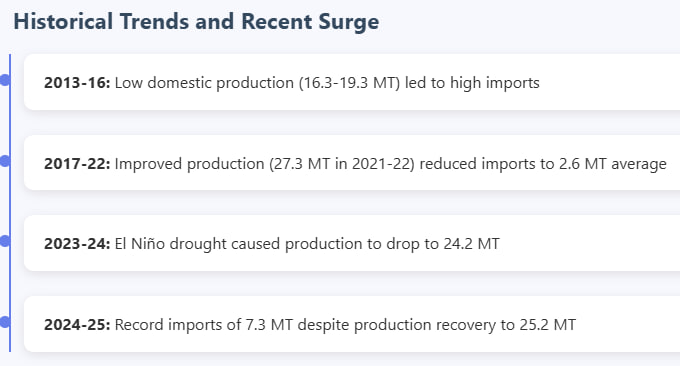



Rising imports of pulses (7.3 million tonnes, $5.5 billion) and edible oils (16.4 million tonnes, $20.8 billion) in 2024-25, driven by low domestic prices and El Niño-induced drought, hurt Indian farmers. With pulses and oilseeds fetching below MSP, reduced import duties may further discourage cultivation, increasing import dependence.

Copyright infringement not intended
Picture Courtesy: INDIAN EXPRESS
The increasing imports of pulses and edible oils are making cultivation of these crops unprofitable for domestic farmers.
In 2023-24, India's pulse imports reached a six-year high, increasing by 84% compared to the previous year.
India imports various pulses to meet its domestic demand, including yellow peas from Canada and Russia, chana from Australia, and arhar (pigeon pea) from several African nations and Myanmar.
The MSP-Market Gap => The MSP is the price at which the government is supposed to buy crops from farmers to protect them from price shocks. However, for many pulse growers, this remains a theoretical benchmark. For example, against an MSP of ₹8,682 per quintal for summer moong, farmers report getting only around ₹6,000 in the open market.
Lack of Procurement => Unlike wheat and rice, where government procurement is robust, the system for pulses and oilseeds is weak and inconsistent. This forces farmers to sell to private traders at prevailing market rates, which are crushed by the influx of cheaper imports.
 Edible Oil Conundrum Imports
Edible Oil Conundrum Imports
India imports about 57% of its total edible oil consumption. This makes it the world's largest importer of vegetable oils.
Dominant Imports => The primary imported oils are palm oil (from Indonesia and Malaysia), soybean oil (from Argentina and Brazil), and sunflower oil (from Russia and Ukraine). Palm oil alone constitutes about 60% of these imports.
In May 2025, the government reduced the basic customs duty on crude palm, soybean, and sunflower oils to control rising retail prices. While this move provides relief to consumers, it directly hurts Indian oilseed farmers. The influx of cheaper imported oils makes domestic cultivation of crops like soybean, mustard, and groundnut less attractive.
High import dependency for pulses and edible oils exposes India's food security to international price shocks and geopolitical disruptions.
Lack of adequate remunerative prices for these crops discourages diversification away from water-intensive staples like rice and wheat.
While MSPs are announced for 23 crops, effective procurement is largely limited to wheat and paddy. For pulses and oilseeds, MSP often fails to act as a safety net, making farming these crops a risky venture.
The high import bill for edible oils puts pressure on India's foreign exchange reserves. The goal of 'Atmanirbhar Bharat' (Self-Reliant India) cannot be achieved without addressing the structural issues in the pulses and oilseeds sector.
National Mission on Edible Oils - Oil Palm (NMEO-OP): Launched in 2021, this mission aims to boost domestic palm oil production by increasing the area under cultivation to 10 lakh hectares by 2025-26. The government is providing subsidies and a viability price to farmers to encourage cultivation, with a special focus on the Northeastern states.
National Mission on Edible Oils–Oilseeds (NMEO-Oilseeds) => This initiative aims to increase the production of traditional oilseeds to nearly 70 million tonnes by 2030-31 through better seeds, intercropping, and land utilization.
Government's reactive, "switch-on, switch-off" strategy towards trade policy must be changed, and a long-term, predictable policy on imports, exports, and tariffs need to be adopted, to give farmers clear price signals, allowing them to make informed decisions about which crops to grow.
The focus must shift from merely managing prices to fundamentally strengthening the agricultural sector. This includes:
Instead of market-distorting price controls that hurt farmers, the government could explore providing direct income support to vulnerable consumers to help them cope with high food prices. This would protect consumers without depressing the market for producers.
Must Read Articles:
Source:
|
PRACTICE QUESTION Q. Critically analyze the role of the Green Revolution in achieving food security and its long-term impact on agricultural sustainability. 150 words |









© 2026 iasgyan. All right reserved